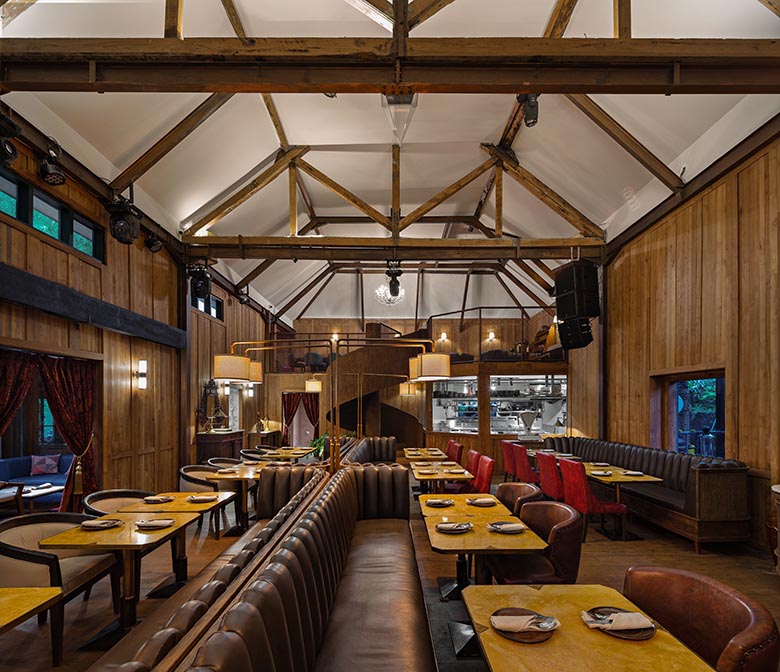Nestled in the Tanah Abang area, close to prominent government offices and the business district, Smriti Jakarta enters the culinary business trend for transforming heritage and historical buildings into stylish, modern-designed restaurants serving a creative fusion of Indonesian food.
Written by Iman Hidajat
Photos by Mario Wibowo
‘Smriti’ means ‘commemoration’ in ancient Sanskrit. As a new restaurant, Smriti Jakarta offers not only a modern and well-designed Indonesian restaurant but also a space to celebrate vivacity of life through its mix of contemporary and traditional Indonesian cuisine.
Arriving at the venue, you will notice the vintage facade, the rustic doors intentionally preserved, in keeping with heritage values. The building itself showcases an eclectic design, with the interiors mixing elegant art deco influences with antiques to create an atmosphere of comfort, like you have arrived in someone’s home.
Inside, the welcome area features a wine cellar containing an extensive wine collection, old books and ancient weapons. The front right corner houses a charming whiskey bar, which exudes a speakeasy ambience with comfortable leather sofas, suitable for a chat and a nightcap.
The next room is reminiscent of an Indo-Dutch living room filled with antiques and trinkets that capture the nostalgia of a busy Sunda Kelapa port, and the Silk Road trades of old Batavia. The antique artworks throughout come from the collection of Smriti Jakarta’s owner. The thoughtful placement of artworks and objects deepens the Indonesian heritage feel throughout the restaurant.
Stepping into the main dining area, through the cinematic red velvet curtains, you will be wowed. The rectangular space is warmly lit and there are three private areas that resemble an old train cabins – like The Orient Express – which create a sense of intimacy.
For a different atmosphere there is also outdoor dining. In the backyard, guests will be closer to the action with an open kitchen in operation amidst a large tropical garden area. Private groups are catered for with two mezzanine areas.
The rooms, equipped with modern facilities, are ideal for business meetings, dining and entertainment for ten to fifteen people.
Initial design consultants from K-Thengono Design Studio were amazed by the space when they saw it. There were different elevations and pockets of space indoors and outdoors. “It creates an opportunity for us to orchestrate new programmes and to redefine the space,” explains Nadia.
The main focus of Smriti Jakarta is to preserve most of the historical elements; thus, the existing facade and original building features became a distinctive design characteristic. “We were deeply inspired by Soho House – the contrast of traditional site with a contemporary and eclectic touch of modern art and furniture. The bold colours and material composition reflect a rich and masculine palette with luxurious touch by using velvet, rich leather, and antique brass to create a mixture of textures and visual sensation,” she continues.
The interior design incorporated local materials such as rattan and batik patterns in the furniture elements. This idea of fusion between contemporary and traditional is also seen the food served.
The menu features cuisine from Sumatra and Java. Like many Indonesian meals that are savoured communally during traditional ceremonies, rituals, and gatherings, the dishes at Smriti Jakarta are best shared, with spicy sambals and krupuk (crackers) as accompaniments.
Chef Harum Indra, Smriti Jakarta Head Chef, created unique twists on traditions. For Sumatran dishes, expect the famous Steak Saus Rendang, Josper grilled instead of stewed, and Tuna Asem Udeng, using tuna belly and black tiger prawn, inspired by his Grandma-in-law’s recipe from Aceh. Other notable dishes are Oyster Bakar, Bobor Jamur Asap, and Klepon Cake for dessert.
“I think the dishes in Smriti Jakarta mostly resonate with my favourite food from Sumatra and Java – food that I can eat daily. I try to make it different using techniques I learned overseas and the best possible ingredients we can source. Also, I am proud that our menu is very collaborative because I developed the dishes with my team. Hence, every food has a different personality,” adds Chef Indra.
The mix of international techniques with local ingredients extends to the drinks menu which has been designed by Mochammad Fadli, a Jakarta-born mixologist with 20-years-experience. Fadli has worked in high profile bars around the world and has won several awards for his creations. His international experience shows in the sophisticated array of bespoke beverages served at Smriti. The main bar showcases Indonesia’s exotic and tropical spices in signature mocktails and cocktails, which will take you on an exciting journey through the archipelago. For example, Batavia, is a whiskey mangosteen cocktail, giving a unique tropical spin on a classic while Pisang Nero reads like a cake recipe – banana milk punch, vanilla, chocolate and cheese – with the addition of cognac and vermouth. Jasmine and Pine is a toasted pineapple tequila with jasmine tincture. Whichever you choose, it’s a perfect way to end the night at Smriti Jakarta.
The eyes have to travel. Indeed, crossing into the Smriti Jakarta universe is not a dull one.
